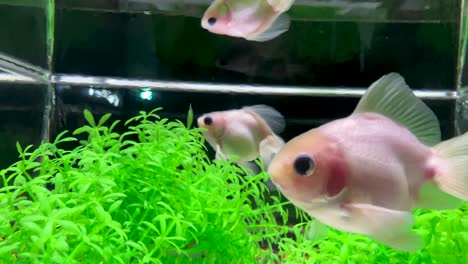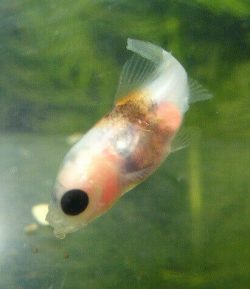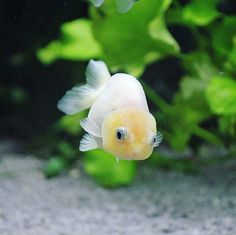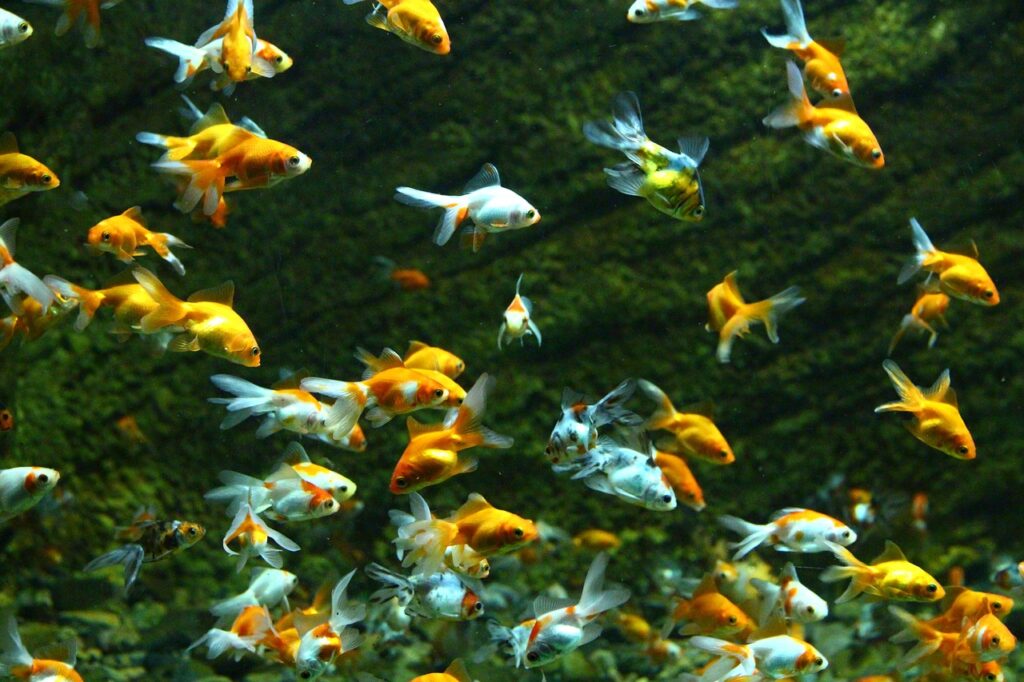
Welcome to the exciting world of taking care of baby goldfish! Just like their terrestrial counterparts, these aquatic tots demand a unique blend of affection and vigilance.
This guide is your map to the uncharted waters of understanding their needs, picking the perfect tank, maintaining a balanced diet, ensuring their health, and handling them safely. Prepare to set sail on this engaging, and occasionally hilarious, journey of baby goldfish care. Anchor’s away!
Understanding Baby Goldfish Needs

When you come across the term ‘baby goldfish,’ don’t think miniature aquatic acrobats with diapers. Yes, it’s a hilarious thought but in reality, baby goldfish are little bundles of joy just as demanding as human babies.
The Essential Needs of a Fry Goldfish
Baby goldfish are like foodie tourists on a seafood diet; they see food and they eat it. They need a high-protein diet to support their rapid growth. Providing the right temperature is equally crucial. While they prefer warmer water, always keep it below 78°F to prevent harmful bacteria growth.
The Difference Between Adult and Fry Goldfish Care
Imagine the baby goldfish as kids at the pool, splashing and bobbing around, while the adults are swimming slow laps to burn off that second serving of dessert. Baby goldfish require more food, safer toys, and careful supervision, unlike the self-sufficient adults.
Understanding what baby goldfish need is the first step. But where are they going to live? In a goldfish hotel? Well, stick around because we’re about to dive into how to select the proper tank for your baby goldfish next.
Selecting the Proper Tank

Ah, the domicile of your golden finned fancy! Picking the right house for your baby goldfish isn’t as simple as picking the prettiest glass box. Nope, there’s a science to this!
Choosing the Right-Sized Tank
A baby goldfish is like a potato chip, you can’t just have one. But pretend for a second that you could resist their cute wiggly faces. Even then, your solo fishy friend will need at least 20 gallons.
Why so big, you may wonder? Well, unlike us, goldfish don’t have an internal growth regulator. This means they’ll continue growing as long as they have enough space. So, a well-sized tank isn’t just a luxurious accessory, it’s a necessity. They need that space to stretch their fins and grow to their full potential.
If you’re looking to purchase a tank for your baby goldfish, we recommend checking out our guide on the Best Tanks for Baby Goldfish. This resource can help you pick a tank that’s not only a good fit for your home, but also a perfect home for your growing goldfish.
The Perfect Tank Environment
Contrary to popular belief, goldfish need more than just a bowl of water to thrive. The key to a healthy, vibrant goldfish is replicating their natural rivers and ponds as closely as possible in your tank. This starts with using coarse sand or gravel as substrate at the bottom, providing an environment similar to their native habitat. Curious about the importance of substrates for baby goldfish? Dive into our article Do Fry Goldfish Need Substrates?
In addition to substrate, incorporating live aquatic plants is essential. They not only supply oxygen but also lend a natural feel to the tank. If you’re wondering which plants to choose, especially for a baby goldfish tank, you may find our article How to Choose the Right Plants for Your Baby Goldfish Tank? quite informative. Also, consider adding hiding spots or caves for your goldfish, emulating the adventurous feel of the wild.
Lastly, maintaining a steady water temperature, ideally between 68 to 74 degrees Fahrenheit, is critical to prevent stress and health issues. With these tips in mind, you’ll create not just a living space, but a ‘Club Med’ for your goldfish—a place where they can truly thrive.
Essential Accessories and Equipment
Let’s talk about the must-haves. An efficient filter is first on the list. It keeps the water clean longer and reduces stress on your fish. Next is a solid heater to maintain correct water temperature.
It’s also good to have a light for your tank. Goldfish aren’t vampires, they need a regular light-dark cycle. And there you go – the ultimate fishy bachelor pad!
So you’ve grasped the concept of a fancy, fit-for-fish living quarters. But what’s next? Stay tuned, because we’re jumping into the wonderful world of goldfish cuisine next.
Feeding Your Baby Goldfish

No two ways about it—feeding your finny friend right is like playing a “Gold”-ilocks scene. But don’t worry, we’re here to help crack the baby goldfish gourmet code!
Right Diet Food
It’s easy to overshoot in the excitement of “feast-time” when baby goldfish are concerned. Keep in mind, they’re not exactly training for an eating contest. Their silverware is primarily made up of brine shrimp, infusoria, or tailor-made goldfish fry food. Interested in hatching your own brine shrimp? Dive into our The Ultimate Guide to Hatching Brine Shrimp. These foods are easy to digest and highly nutritious—in other words, baby goldfish chow at its finest!
If you are interested in a more comprehensive list, check out our article on the 4 Best Foods for Baby Goldfish for additional options and in-depth information.
Oh, and occasionally, you can toss in a boiled veggie or pea. Just think of it as ‘dessert’. Experiment a bit and observe your little swimmer’s reactions. But remember, less is more. Providing a varied diet not only ensures nutritional balance but also helps your goldfish to grow strong and healthy. So, be mindful of their eating habits and adjust their meals accordingly.
Feeding Schedule and Quantities
Baby goldfish are indeed tiny, yet their appetite is mighty! It might seem hard to believe, but these little aquatic critters require feeding every two to three hours. Think about it like this—imagine you’re engrossed in a captivating sitcom, and it feels like you’re encountering ads almost every five minutes. That’s the sort of feeding schedule your baby goldfish is on!
However, it’s essential to keep in mind that this does not give you a license to overfeed. The aquatic rule of the fin recommends offering food that your little ones can polish off in less than two minutes. Feeding them more than that could lead to significant problems. It’s akin to leaving a full buffet out after closing time. It’s not a pretty sight and certainly not beneficial for your tiny aquatic friends.
While it may seem like a demanding feeding schedule, especially if you have a busy routine, there are modern solutions that can help manage this effectively. To learn more about this, check out our detailed article on Automatic Feeders and Fry Goldfish. This article will provide you with useful tips and tools to ensure your baby goldfish get the timely nutrition they need, without interrupting your daily schedule.
Common Feeding Mistakes to Avoid about Take Care of Baby Goldfish
In the business of baby goldfish parenting, it’s often the small blunders that lead to big problems. For example, food that rests at the bottom of the tank can make the water sludgy and unhealthy.
Another miss is offering only dried food. Though convenient, relying on dried foods alone deprives your baby goldfish of their need for variety. It’s significant to balance this with the other nutrient-packed foods we mentioned.
Debunking myths and knowing what not to do is as crucial as feeding right. With this in hand, you’re a step closer to having a jubilant, healthy baby goldfish.
So, now you know exactly what to put on your baby goldfish’s dinner plate! Next up, we’ll tell you how to identify if your baby goldfish is the picture of health—or the opposite. Get ready for Goldfish Health 101!
Ensuring Good Health and Longevity

Ensuring the good health and long life of your baby goldfish is as important, if not more, than feeding them and providing them with the right environment. This section will provide everything you need to know on how to keep your small fish friend healthy and swimming for years to come. Don’t worry, it’s as simple as spotting a goldfish in a clear tank!
Signs to Look for In Healthy vs Unhealthy
Healthy baby goldfish have bright, vibrant colors and clear eyes. Their bodies should be fully formed and free from sores or irregularities. Their activity levels should be high, as they’re known for their curious and playful nature.
On the fin flip side, sluggish movements, pale colors, cloudy eyes, or spots on their bodies can point towards poor health. Anything that seems off or different from the norm might be a sign of trouble. So keep your eyes peeled.
After learning the signs of good health and potential problems, it’s time to talk about how to tackle these issues.
How to Keep Your Fry Goldfish Healthy
Alas, baby goldfish can get sick, too. There’s ick, also known as white spot disease, a highly contagious parasite. Mild cases can be treated by raising the tank’s temperature slowly over a few days. Fungus, often seen as a fluffy growth on the skin, can be managed with commercially available antifungal treatments.
Fish aren’t like cats with their nine lives. So, one major rule here: do not attempt to play fish doctor and diagnose complicated illnesses yourself. If there’s anything that worries you, consult a professional, or you might be playing “Finding Nemo” in real life!
Now you know about identifying health problems and solutions. But, how about preventing these issues in the first place through regular care and check-ups?
Regular Care and Check Up Routines
Because an ounce of prevention is worth a pound of cure, regular check-ups and cleanings are critical. Once a week, make it a routine to check your water quality and temperature. It won’t take much time, and it’ll keep your fish swimming happily.
Tank cleaning is usually needed every two weeks. Remember, a tidy home is a happy home, even for fish! Don’t forget about your filter! It needs some love too and should be cleaned at least once a month (or more depending on usage).
So there you have it – the roadmap to keeping your baby goldfish healthy and strong! But wait, there is more! It’s your interaction time with your tiny aquatic pet covered next! Isn’t keeping fish fun?
Handling Your Baby Goldfish

We’ve finally made it to the final arena. Let’s dive straight into the art of handling these little golden munchkins.
The Correct Way to Handle
Despite what those Saturday morning cartoons have taught you, you can’t take our fishy pals out for a cuddle. They belong in the water, always. But sometimes, you might need to move them for cleaning or health check-ups. In such scenarios, use a soft and clean fish net. Move slowly, be gentle and always, I mean always, wet your hands before you touch them… if you have to touch them.
The ‘Don’ts’ When Interacting with Your Pet
Commence the drumroll please, here are the grand ‘Don’ts’ in goldfish parenting. Don’t overfeed, which is a classic rookie mistake. Don’t let the water get dirty, ’cause nobody likes a bad neighborhood. Most importantly, never ever try to touch your pet without washing your hands. We may love fast food fingers but our fishy friends sure don’t!
Introducing Your Goldfish to Other Fish
Ready for the big ‘Meet and Fish’, I mean ‘Meet and Greet’? Start by letting them see each other but not mingle, maybe divide the tank. Once they get used to each other, let them interact in the main tank but watch closely. No room for mean fish bullying! Remember, gradual is the pace and patience is the key.
Anyway, that concludes our happy swim through the world of baby goldfish parenting. Now you are armed with knowledge, wisdom, and a smidge of my infused humor, ready to rock the baby goldfish world. Just remember, with great power comes great responsibility! So, treat those finny friends with care, respect and tons of love.
To Sum Up
We’ve journeyed through the nuances of caring for your baby goldfish, proving it’s more than just keeping a fish afloat! Now, equipped with this knowledge, you’re set to offer your finned buddy a nurturing home.
Remember, caring for a baby goldfish is a blend of understanding their needs, providing the right environment, feeding them properly, monitoring their health, and handling them gently. Happy ‘fish parenting’!
Frequently Asked Questions (FAQ)
Question 1: What are the basic needs of a baby goldfish?
Answer: Baby goldfish need a proper diet, good quality water, ample space to swim, and a stimulating environment. It’s essential to maintain the water temperature, pH levels, and keep their habitat clean to ensure their well-being.
Question 2: How different is the care for baby goldfish compared to adults?
Answer: Baby goldfish are much smaller and more delicate than adult goldfish, requiring a more controlled environment and a diet rich in protein. They also need more frequent partial water changes to keep their environment healthy.
Question 3: What should be the size of the tank for my baby goldfish?
Answer: Baby goldfish require at least a 10-20 gallon tank. As they grow, it might be necessary to upgrade to larger tanks. Goldfish are known to grow to the size of their environment!
Question 4: How often and how much should I feed my baby goldfish?
Answer: Feed your baby goldfish 2-3 times per day, only the amount they can eat within 2 minutes. Overfeeding can cause health problems and dirty the water.
Question 5: What are some signs of a healthy vs. unhealthy baby goldfish?
Answer: A healthy baby goldfish will have bright colors, clear eyes, a hearty appetite, and active swimming behavior. Signs of an unhealthy goldfish could include lethargy, refusal to eat, faded colors, and abnormal swimming patterns.
Question 6: What are some common diseases in baby goldfish and how can I treat them?
Answer: Common goldfish diseases include Ich, Fin Rot, and Swim Bladder Disease. Most can be treated with water changes, medication, and sometimes adjusting the diet.
Question 7: How should I handle my baby goldfish?
Answer: It’s best to avoid handling your goldfish as much as possible. Use a soft mesh net for any necessary moves and always keep your hands wet to protect their sensitive scales if you must handle them.
Question 8: Can I introduce my baby goldfish to other types of fish?
Answer: Yes, as long as you understand the specific needs of each species. Some fish may not be compatible with goldfish due to differing water conditions or dietary needs. Always do your research first!



